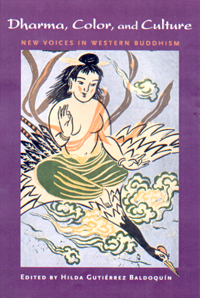Dharma, Color, and Culture: New Voices in Western Buddhism
Hilda Gutiérrez Baldoquín, editor
Berkeley: Parallax Press, 2004
200 pp.; $16.00 (paper)
“Dharma is coming full circle—to the ears, hands, and hearts of people of color where it began many centuries and generations ago in the time of the Buddha. This is a crucial pivoting point.” So says Kamala Masters in her foreword to this timely new compilation of essays, Dharma, Color, and Culture: New Voices in Western Buddhism, edited by Hilda Gutiérrez Baldoquín. Each of the twenty-six contributors, racially diverse and of different Buddhist traditions, establishes the precious connection to the fundamental truth of the dharma: From the experience of even the most profound suffering, our minds and hearts can flower into wisdom and compassion.

As Masters reminds us, the Buddha was a person of color “who taught to all those who were interested, regardless of their caste or clan.” Baldoquín points out in her introduction that “when speaking of the history of Western Buddhism in general—and its presence in the United States, in particular—it’s imperative that the point of origin not be located in a white, European American context. The story of how the Dharma reached the shores of the United States is embedded in the history of immigrants of color.” In this one volume, the suffering and despair peculiar to this history is on display in its manifold forms.
The book is organized in five sections, one for each of the Buddha’s Four Noble Truths plus a fifth—the Truth of Bringing the Teachings Home—devised by Baldoquín. Each essay essentially bears witness to the 2,600-year-old message of the Buddha—that our self-created suffering can be healed. As a collection it is unflinching in its homage to the First Noble Truth of the existence of suffering, yet it does not tarry there. Rather, the essays skillfully travel the path from suffering to peace in a way that will uplift and touch readers of all “castes and clans.”
The oral tradition seems very much alive here. These are essays about all of our humanity reverberating through time, speaking directly to us and opening our hearts to these unexcelled teachings in a personal and direct way.
As we learn from Alice Walker:
White racism…is the arrow that has pierced our collective heart. For centuries, we have tried to get the white archer to notice where his arrow has landed; to connect himself…to what he has done…. This teaching says: Enough. Screaming at the archer is a sure way to remain attached to your suffering rather than easing or eliminating it. A better way… through meditation…study and practice, [is] to free yourself from the pain of being shot, no matter who the archer might be.
Along with stories that move our hearts, we are treated to a wide spectrum of wisdom, relative and absolute. We weep with Maxine Hong Kingston in her affecting story of a firestorm that devastated her house and her precious draft manuscript. We soften reading Zen priest Merle Kodo Boyd’s “Child of the South in Long Black Robes,” about a child of the Jim Crow South who recognizes herself in a Chinese Zen painting. We immerse our minds in the treatise by Buddhist scholar Charles Johnson, who meticulously shows us that within the framework of the Eightfold Path can be found all the “great treasures of the Buddha-dharma;” and we awaken with dharma teacher Viveka Chen to the empowering, simple, and difficult truth that “even in oppressive conditions, freedom can be had by freeing the mind.”
This is a new turning of the dharma in our Western community. We have come full circle, and in that circle is a broad spectrum of experience, honoring richness in diversity, yet not losing sight of our common humanity.